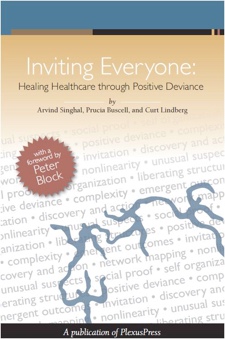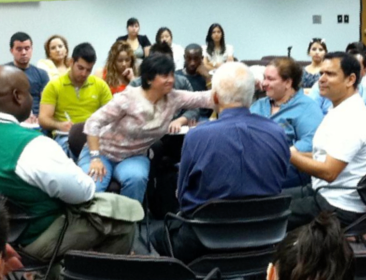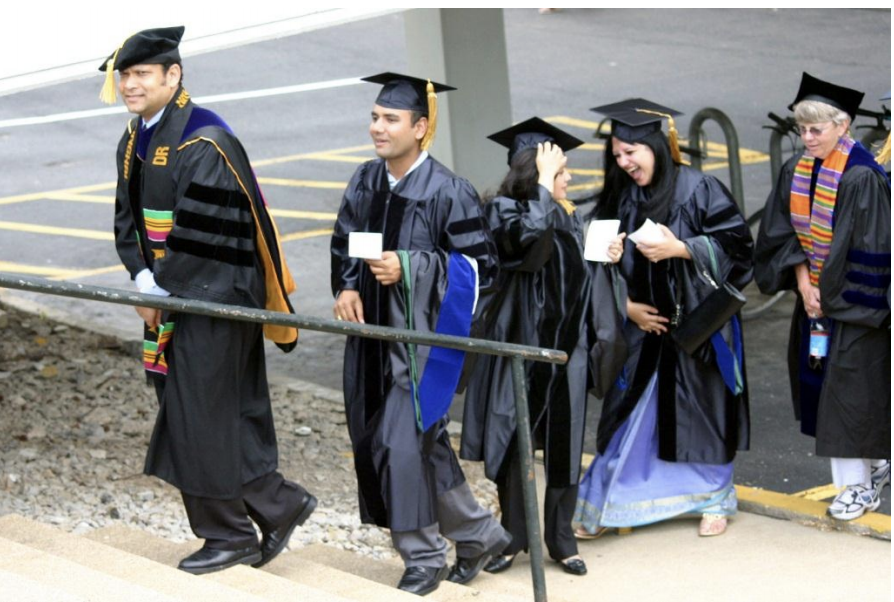

What explains the enhanced psychological resilience of students at VMBO schools in the Netherlands? The Positive Deviance Approach in Action —- Martine Bouman, Sarah Lubjuhn, & Arvind Singhal (2014) —- http://localhost:3000/#
Martine Bouman, Sarah Lubjuhn, & Arvind Singhal (2014)

Invite Everyone – Healing Healthcare through Positive Deviance —- Arvind Singhal —- https://example.com
Positive Deviance (PD) is an approach to social change that enables communities and organizations to discover the wisdom they already have, and then to act on it. The premise of PD is that in every community there are certain individuals or groups whose uncommon practices or strategies enable them to find better solutions to problems than neighbors and peers who have access to the same resources. PD is led by people in the community who help identify and spread the successful practices. Ideas for change are more likely to be accepted and adopted when they are based on existing local wisdom than they are when outside exports try to impose them. This book tells the remarkable story of how a people-centered approach to organizational and social change, accompanied by sound scientific and technical expertise, yielded positive quality outcomes for ordinary citizens, health care institutions and their patients, and society in general. This work draws upon the collective wisdom and experience of infection control practitioners, doctors, public health authorities, nurses, social and organizational change practitioners, health care administrators, patients and front line workers. Additional benefits of use of the PD process to fight infection turned out to be improved workplace relationships, Positive Deviance (PD) is an approach to social change that enables communities and organizations to discover the wisdom they already have, and then to act on it. The premise of PD is that in every community there are certain individuals or groups whose uncommon practices or strategies enable them to find better solutions to problems than neighbors and peers who have access to the same resources. PD is led by people in the community who help identify and spread the successful practices. Ideas for change are more likely to be accepted and adopted when they are based on existing local wisdom than they are when outside exports try to impose them. This book tells the remarkable story of how a people-centered approach to organizational and social change, accompanied by sound scientific and technical expertise, yielded positive quality outcomes for ordinary citizens, health care institutions and their patients, and society in general. This work draws upon the collective wisdom and experience of infection control practitioners, doctors, public health authorities, nurses, social and organizational change practitioners, health care administrators, patients and front line workers. Additional benefits of use of the PD process to fight infection turned out to be improved workplace relationships, healthier and more resilient organizational cultures, and expanded networks of people in many fields and geographical locations who shared ideas, resources and the inspiration of their own contributions to saving lives.

A Liberated Professor Speaks —- from the Social Justice Initiative —- Boby Gutierrez / Lucía Durá
“I cannot imagine not being a professor,” I remarked to Dr. Josefina Tinajero, the Dean of the College of Education at the University of Texas at El Paso, this past week after an educational video shoot in her office. “What better vocation could there be than to be part of an ongoing learning community, buoyed and drowning in the vortex of ideas,” I emphasized. She nodded.
In the past 29 years, I have taught an estimated 4,500 to 5,000 students in 150 semester or quarter-length courses in 20+ subjects offered through universities in the U.S, Canada, Germany, Thailand, Malaysia, and India. The sailing has been smooth; enjoyable, in fact. My scorecard: A mountain of crests and a handful of troughs (happily forgotten)!

One thing for sure: My quality of life as a professor has risen sharply with the distance covered. I feel it in my bones. I sense it in my stride in entering a classroom.
Need no MyersBriggs, no empirically-validated scales; I know what I know. I feel what I feel. Professors who revel in their vocational calling often hear their students say: “Professor, I enjoyed your class. I learned a lot. I thank you, and so on.” Such remarks, whether expressed orally, or penned in course evaluations and thank you notes, warm the heart and buoy the soul. I have been graced and buoyed by such warmth over the past 29 years. However, in the past eight years or so, the nature of the student feedback I hear has noticeably changed. Qualitatively, it is deeper, more soulful. I increasingly hear: “This class changed my life;” “I learned so much about myself in this class;” “I am sad that this course is ending for I will miss my classmates;” and so on. And, I have even heard students say: “Thank you for teaching me about healthy communities. But thank you also for teaching me how to learn.” Such statements more than make a professor’s day. It makes a student’s life! How do I explain this qualitative shift in student feedback? Perhaps, it is because I am getting older, wiser. Perhaps, my abilities to connect the classroom with the real world have multiplied appreciably. Perhaps I have learned to better manage classroom conflict. Perhaps I can at the drop of a hat pull out a compelling story to illustrate a point. Or, all of the above!
I believe, there may be one more explanation. In the past eight years, I have increasingly been exposed to, and have put to practice, some alternative ways to approach and design my classroom interactions. These alternative approaches, called “Liberating Structures” were developed by my friends and complexity science practitioners, Keith McCandless and Henri Lipmanowicz, whom I first met in 2003 through meetings of the Plexus Institute in New Jersey. At that time, Keith and Henri had begun to experiment with, and codify and systematize, several Liberating Structures to replace or complement commonly-employed instructional practices such as straight lecture, or free-flowing brainstorming. By 2012, they had systematized 33 liberating structures (see www.liberatingstructures.com)


